Kathakali Style
Kathakali is a bright dancing performance from the rich and fertile southern
state of Kerala. It is the most colorful, sincere and passionate dance form in
India. As an art of
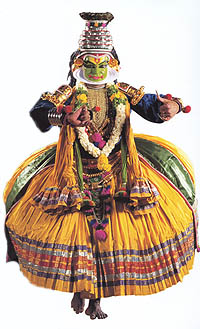 unique depth and human warmth it includes humorous comments
that miss none of aspects of human life. It is far from being just a drama. Even
when a Kathakali dancer plays a scene alone his poetical art creates imaginary
space that acquires real boarders and stretches to the farthest horizons of the
emotional. unique depth and human warmth it includes humorous comments
that miss none of aspects of human life. It is far from being just a drama. Even
when a Kathakali dancer plays a scene alone his poetical art creates imaginary
space that acquires real boarders and stretches to the farthest horizons of the
emotional.
Although in its present form Kathakali appeared in about XVII century its roots
go back to various folk and dramatized forms of entertainment that appeared much
earlier. Among them Chakiar Kothu, Kudiyattam, Krishnattam and Ramanattam had
the most direct influence upon Kathakali. The sources of inspiration for it also
were the ancient forms of hand-to-hand combat and folk traditions of Kerala.
Chakiar Kothu was a dramatized kind of art performed by only one caste –
chakiaras. Their right to perform in temples of Malabar was passed down from
generation to generation and only elite public was admitted to these strictly
canonized performances to be sure take place on temple territory. A chakiar was
a witty imitator; he played scenes from epic poems and puranas. He was
accompanied by a namizhava, a big brass drum with a relatively small membrane,
and by cymbals played on by a woman.
In state Kerala the drama was born in the form of Kudiyattam. A popular legend
was performed by several actors together, one plot could be played for several
days at that, and the art of mukha abhinaya (drama art) developed into a complex
technique. Performances took place by night. Definite make-up colors and
costumes started to be appointed to every character. The ruling Perumalas and
later Kulashekhara, the king of Chera, patronized this kind of art.
Training and teaching in hand-to-hand combat in Kerala had the purpose of
charging body and mind with energy by means of physical perfection. A beautiful
military caste of nayaras devoted themselves to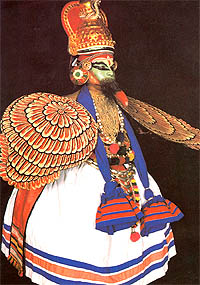 this. Like in the countries of
the Far East battle methods were used here. But in spite that tools were used
during trainings the purpose was physical training and self-defense. Young
nayaras many of whom later reached the heights of mastery were trained in
ksharis (gymnasiums) in a scientific method of body massage and vigorous
exercises. this. Like in the countries of
the Far East battle methods were used here. But in spite that tools were used
during trainings the purpose was physical training and self-defense. Young
nayaras many of whom later reached the heights of mastery were trained in
ksharis (gymnasiums) in a scientific method of body massage and vigorous
exercises.
The rite of Krishnattam was developed in XVII century by a zamorin (a ruler) of
Calcutta as an offering to Krishna. It used to be performed in Guruvayur temple
or in zamorin’s temple. The text of the performance lasted for eight nights and
was performed in Sanskrit. They say it was written under the influence of
popular at that time "Gita-Govinda" by Jayadeva.
Soon after that Ramanattam a story about Rama appeared. It was composed by Raja
Kottarakkara a commander from the southern Kerala. A legend says that he once
asked a zamorin to lend him his troupe that performed Krishnattam but was
refused. Being insulted he made up his mind to create a similar eight-day
performance based on Krishna’s story of life. As far as it was performed not in
Sanskrit as Krishnattam but in the Malayalam language, it soon left Krishnattam
far behind in popularity. Pantomime and gesticulation were used in Ramanattam.
The art of complex make-up developed, musicians were invited for the
accompaniment, certain conditions for characterization of personages appeared.
Soon plots started to include stories from "Mahabharata" and Puranas. This form
of dance drama grew up, developed and got the name of Kathakali, literally a
story-play.
Local kings and the land aristocracy were proud of being able to support their
own troupes and
 generously helped to develop the new style. Among them the
following can be marked out: Thampurana from Kottayama and some rulers from the
Travankur dynasty such as Balarama Varma, Asvati Tirunal and Svati Tirunal Gama
Varma. A poet Iraiman Thampi also made great contribution to the development of
the genre in both his literary talent and monetary contributions. With a support
like this the style flourished and widened its frames. Later with the gradual
decline of the might of royal families, Kathakali began to give its way to more
popular forms of entertainment; Kathakali actors could not support themselves
any longer. Performances continued to take place in some areas but without the
former scope. This kind of art was saved from a threatening and complete
disappearance by a great poet Vallathol Narayana Menon who in 1930 founded the
Center for preparation and training in Kathakali named Kerala Kala Mandalam. generously helped to develop the new style. Among them the
following can be marked out: Thampurana from Kottayama and some rulers from the
Travankur dynasty such as Balarama Varma, Asvati Tirunal and Svati Tirunal Gama
Varma. A poet Iraiman Thampi also made great contribution to the development of
the genre in both his literary talent and monetary contributions. With a support
like this the style flourished and widened its frames. Later with the gradual
decline of the might of royal families, Kathakali began to give its way to more
popular forms of entertainment; Kathakali actors could not support themselves
any longer. Performances continued to take place in some areas but without the
former scope. This kind of art was saved from a threatening and complete
disappearance by a great poet Vallathol Narayana Menon who in 1930 founded the
Center for preparation and training in Kathakali named Kerala Kala Mandalam.
It is impossible to overestimate Vallathol’s foresight. He invited many eminent
teachers and actors to Mandalam among whom were such leading figures as Ravunni
Menon and Kunju Kurup. Thus Kathakali survived, got stronger and turned into a
force one cannot but count with.
While watching Kathakali sometimes there is an impression that a dancer knows no
oral language, so freely he possesses the sign language. This language together
with quite complex and figurative use of mimicry is the essence of the style. A
performer interrupts a dialogue with movements drawn from the pure dance but can
also lead a ceaseless conversation with the help of gesticulation. Even when a
hero thinks, plans or remembers something a dancer translates all this into
gestures thus initiating spectators into a train of thought of a personage. A
part of a dialogue may include lyrics written especially for the given hero or
for the scene performed. The lyrics are sung by two singers in turn. A dancer
interprets lyrics very thoroughly, first translating each word in a line for
word into gestures and then varies the interpretation of the same line in order
to include the situation, a reaction to the situation, possible consequences or
results of this situation etc. Thus a relatively short poetic fragment is
interpreted by a dancer in a rather wide way.
In order to freely transmit thoughts with the help of gestures and mimicry a
Kathakali dancer must go through exhausting training that will teach him to
creatively use body and mind abilities, will give him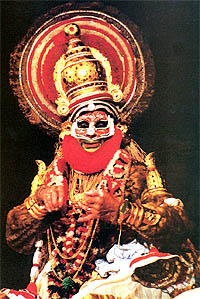 the skills necessary for
the future work. Boys begin to study in gurukul (a school) at the age of ten and
learn from sunrise till sunset. Every day professional masseurs massage the boys
using special oils for muscles and joints relaxation, giving them elasticity
necessary for dances of this style. This firstly painful massage followed by a
bath taking is done daily during the whole period of learning that usually lasts
till the boys are twenty years old. A dancer lies down on the floor and a
masseur massages with his feet counting every muscle, joint or nerve. Legs, arms
and in particular toes as well as all other parts of body are massaged. As a
result a dancer senses every part of his body independently from other parts,
and in the future he will be able to manage and use them on his own accord. the skills necessary for
the future work. Boys begin to study in gurukul (a school) at the age of ten and
learn from sunrise till sunset. Every day professional masseurs massage the boys
using special oils for muscles and joints relaxation, giving them elasticity
necessary for dances of this style. This firstly painful massage followed by a
bath taking is done daily during the whole period of learning that usually lasts
till the boys are twenty years old. A dancer lies down on the floor and a
masseur massages with his feet counting every muscle, joint or nerve. Legs, arms
and in particular toes as well as all other parts of body are massaged. As a
result a dancer senses every part of his body independently from other parts,
and in the future he will be able to manage and use them on his own accord.
In the main Kathakali position knees must be moved apart to give body a wide
basis. The back is arched and supports the body weight in free movements that
are characteristic of the style, and also the weight of a heavy headdress. When
a dancer stands in this position it looks like he sits on a stool. Out of this
position a dancer moves forward and backwards, sits down on the floor, jumps and
stretches himself on the floor. Knees are not often joined together only in case
an actor stands straight what happens when he is motionless or simply listens to
another hero of the action.
Not only body is subject to systematic exercises but also every part of a face
especially eyes. It is as exhausting as training other parts of body and
requires great concentration. A dancer sits on the floor with his legs crossed
and arms folded on his chest or on laps. He presses chin to his chest and opens
his eyes wide. Then he starts to move his pupils horizontally, vertically and
circle-wise. He draws eights with his eyes first slowly then faster until it
becomes hard to watch their movements. It reminds meditation because thoughts
calm down, only the muscles around eyes move.
It is not allowed to move during this exercise, while eyes work a dancer’s head
and body must be absolutely motionless. Then brows, chin, cheeks, mouth, neck
and head are trained at first separately, then in various combinations. The
purpose of these exercises is to teach a dancer to control facial muscles and be
able to completely manage its different parts. This emphasizes the elegancy of
mimicry elements during a performance.
The performance of nrytta or pure dance is based on strict adherence to the
system of basic figures and jumps from the semi sitting position. It is uneasy
in itself to learn a great number of motions and figures by heart, but the main
thing is to understand their meaning in characters and moods of various
personages. A finished fragment of a pure dance is called kalasam. It would be
untrue to expect every dancer to interpret a given kalasam in the same way. A
dialogue of actors alternates with kalasams, that’s why the interpretation and
performance depend on the song rhythm in the scene, on the mood of the episode
and first of all on the portrayed personage. A dancer may win the audience
approval by performing kalasams vigorously, gracefully or excitedly or cut them
short sharply, all that depends on the preceding dialogue. For instance, for
personages like Hanuman there are traditional compositions performed by
experienced dancers who are guided by their temperament, age and reputation.
Kathakali dancers use a complicated sign language. It is based on the book
"Hasta Lakshana Deepica"
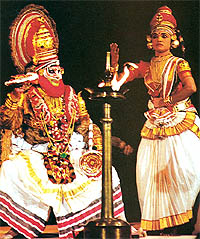 that contains the developed rules of 24 most important
hastas. However, because of the great number of their combinations it is
impossible to say for sure that there is any complete list of them. So much
depends on the mastery and imagination of a dancer that true leading figures of
Kathakali and other styles eventually raise high over the instructions of
technique and resort to fewer hastas or to any other motions and figures
regulated by rules. that contains the developed rules of 24 most important
hastas. However, because of the great number of their combinations it is
impossible to say for sure that there is any complete list of them. So much
depends on the mastery and imagination of a dancer that true leading figures of
Kathakali and other styles eventually raise high over the instructions of
technique and resort to fewer hastas or to any other motions and figures
regulated by rules.
Hastas are visual portrayal of lyrics. A musician adds melody to lyrics thus
shading their meaning. By mimicry, motions and gesticulation a dancer introduces
sense and life into poems, turning acoustic images into visual ones.
A Kathakali dancer widely uses metaphors. It is believed that all the living
things can be correlated with the nature, and hastas are built on such
correlations. Besides, hastas in Kathakali may denote such notions as "the same",
"even", "but", "with" etc., what is of rare occurrence in the dance. Every
language has its phraseology, its rhythm, its consequence of words. Kathakali
seems wonderfully correlates with sanskritized Malayalam that serves as a means
of its oral expression.
In a narrative episode an actor may choose one of the following variants. He may
describe physical notions such as a mountain, a palace, a forest, a garden, fire;
on the other hand he may portray a woman, an elephant, a bee, a lotus, an enemy
etc. Or he may remain himself and react to a situation by playing rage, despair,
greed, humbleness, arrogance, passion or contempt.
While developing his idea an actor chooses the corresponding comparison and
quite visibly renders the meaning of what he wants to say in detail description
of what he compares. For instance, in portraying a bashful woman, this trick may
turn out very effective for it shifts the audience attention from a woman’s
personality upon the main idea of a dancer. A hero may look at his beloved, shy
and silent but full of love and passion. He compares her with liana and says:
"You are so tender and shy; you remind me a liana that winds around the tree and
cannot grow on her own". Then an actor develops this idea for quite a long time,
first portraying his beloved by showing in details how shy and fragile she is,
then he demonstrates how she stands with her head bowed and eyes down; after
that he looks at the imaginary liana and shows how it grows winding around a
tree etc.
In this is the difference of Kathakali from other styles, this is an absolutely
visual form of art. This is "the absolute theatre" both on the level of one
performer and in a wider meaning as a theatre action. The purpose of an actor is
to create a character that probably was not developed in a play. And not just to
create the character of a mighty Bhima whose part he may play but to show to the
audience the flowers growing on his way, a woman he loves, the depths of the
forest he makes his way through, arrogance of his enemies and his oath of
revenge. All his emotional sorrows and joys are reflected in his behavior and
the way he walks. Different opportunities are hidden in him, both trivial and
supernatural ones. While watching him a spectator cannot but admire the strong
portrayal of the superhuman and the honest portrayal of the human.
According to tradition a Kathakali has always been performed by night on a
simple open platform without decorations, side-scenes, curtain and backstage.
The only "properties" was and still is a traditional stool that actor may use on
his own accord as a throne to sit solemnly on, as a tree to climb up or just a
chair to rest on while another actor plays in proscenium or in the stage center.
He may place it anywhere and move from place to place if the development of plot
requires this. Therassila or screen is used very effectively to hide the
appearance of a new personage. Two men hold the screen in front of an actor in
such a way that the audience can only see his legs and the headdress. The true
symbolism of his costume is hidden from them and every new personage begins his
performance with exclamations from behind the screen thus creating a strained
anticipation with the audience. By the time the screen is taken away he already
becomes a full participant of the action and is completely associated with the
role he plays. traditional stool that actor may use on
his own accord as a throne to sit solemnly on, as a tree to climb up or just a
chair to rest on while another actor plays in proscenium or in the stage center.
He may place it anywhere and move from place to place if the development of plot
requires this. Therassila or screen is used very effectively to hide the
appearance of a new personage. Two men hold the screen in front of an actor in
such a way that the audience can only see his legs and the headdress. The true
symbolism of his costume is hidden from them and every new personage begins his
performance with exclamations from behind the screen thus creating a strained
anticipation with the audience. By the time the screen is taken away he already
becomes a full participant of the action and is completely associated with the
role he plays.
A big lamp is placed in the front part of the platform; oil is added in it from
time to time. It gives beautiful natural yellow light waving to the wind in
contrast to stable rays of modern projectors. The level of illumination
naturally singles out a rather small circle where the action takes place, and
attracts the audience attention to it. When an experienced actor wants to
emphasize the smallest (finest) changes in mimicry he may take a sit under the
lamp and then every movement of his eyes, neck, chin and brows will become
brightly outlined and reflected on his face because a flickering flame as if
"highlights" it properly and at the same time makes waves of light across the
face in contrast to modern projectors that make light and shade freeze on place.
The term Aharja abhinaya is used in relation to costumes and make-up. In
Kathakali more than in any other style of Indian dance these two elements serve
as a necessary link for understanding characters of dance drama. The heroes and
plots in Kathakali tell about supermen. Legends about gods and demons are
transferred upon the stage, and each personage possesses supernatural and
sometimes divine forces. Traditions of make-up originate from the ancient forms
of folk art of Kerala and also in Kudiyattama and Krishnattama. In time the
costumes grew better and the whole performance makes the impression of a
complete splendour. Dancers have large skirts, shirts and various beautiful
ornaments on: bracelets, ribbons on wrists, chest plates, several rows of bells
on ankles and calves, a very heavy and painted headdress and long artificial
hair. Costume, ornaments and make-up are so complicated that it is hard to
imagine how actors can dance so vigorously with such a load.
Personages of the Kathakali drama are divided into three big dramatic types:
sattvik, rajasik and tamasik.
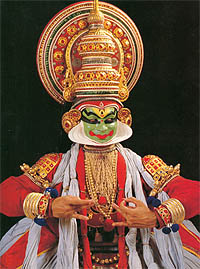 Sattvik: noble, heroic, generous and refined heroes. Their make-up is put on a
bright green background which is called pachkha in the malaylam language. A
white chutti is drawn from jaws to ears. It serves as a boarder sharply
outlining face, on which background a complicated make-up stands out especially
brightly. Sattvik: noble, heroic, generous and refined heroes. Their make-up is put on a
bright green background which is called pachkha in the malaylam language. A
white chutti is drawn from jaws to ears. It serves as a boarder sharply
outlining face, on which background a complicated make-up stands out especially
brightly.
Lips are painted with a glittering pink colour, two little circles are drawn in
the corners of the mouth. Eyes are penciled with sharp black strokes from the
internal sides of eyes near nose up to the hair line. A complicated religious
sign naman is drawn on the forehead. The heroes with pachkha (green make-up)
have fine, elegant and aristocratic appearance. Among them are Bhima and Indra.
Krishna has green make-up on his face too, but his headdress (muti) is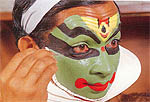 not so
big, with fewer spangles and on the top it is decorated with a semicircle made
of peacock feathers. Other personages with pachkha have multicoloured
headdresses, kiridas, they are much larger than mutis and are brightly decorated
with green, white and reddish spangles. The heroes with green make-up usually
have white skirts and red jackets on; Krishna wears a blue one. The actors
playing Shiva and Brahma put their make-up on a pale orange background, pajuppa,
the rest of the make-up, costume and headdress is similar to the personages with
pachkha. not so
big, with fewer spangles and on the top it is decorated with a semicircle made
of peacock feathers. Other personages with pachkha have multicoloured
headdresses, kiridas, they are much larger than mutis and are brightly decorated
with green, white and reddish spangles. The heroes with green make-up usually
have white skirts and red jackets on; Krishna wears a blue one. The actors
playing Shiva and Brahma put their make-up on a pale orange background, pajuppa,
the rest of the make-up, costume and headdress is similar to the personages with
pachkha.
Rajasik is an antihero like Ravana, Duryodhana and Kichaka. Their make-up is
called katthi. The green colour of the background remains because the heroes
with katthi possess positive qualities too: generosity, devotion, nobleness and
love. However, the green background is crossed out by bright red lines across
forehead, nose and cheeks by which they can immediately be identified.
However, what immediately marks these heroes out is two chuttipos, white balls
made of plant pulp
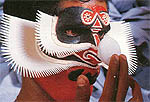 that are fixed on the forehead and the tip of the nose. The
same balls can be found with very wicked and mean "bearded heroes". A hero with
katthi, with his costumes and headdresses reminds the personages with pachkha.
His character is arrogant and aggressive. He does not stand rivalry and will not
miss the opportunity to boast of his virtues and valour. He gets angry easily;
he does not listen to the voice of reason and responds sharply to reproaches. In
the presence of his beloved who usually comes in his dreams, the impudent and
arrogant hero with katthi becomes sentimental and humble. He is quite often the
most memorable among the personages and frequently is the audience favorite. At
his will a hero with katthi exposes a pair of fangs to demonstrate his rage. The
roles of antiheroes are very popular and serve as a test for dramatic talent of
an actor. A dancer utters various sounds starting with a sweet and tender cooing
during the conversation with a beloved or while praising her, up to long and
loud howls and roar when meeting an enemy. These heroes are the decoration of
the evening performance. that are fixed on the forehead and the tip of the nose. The
same balls can be found with very wicked and mean "bearded heroes". A hero with
katthi, with his costumes and headdresses reminds the personages with pachkha.
His character is arrogant and aggressive. He does not stand rivalry and will not
miss the opportunity to boast of his virtues and valour. He gets angry easily;
he does not listen to the voice of reason and responds sharply to reproaches. In
the presence of his beloved who usually comes in his dreams, the impudent and
arrogant hero with katthi becomes sentimental and humble. He is quite often the
most memorable among the personages and frequently is the audience favorite. At
his will a hero with katthi exposes a pair of fangs to demonstrate his rage. The
roles of antiheroes are very popular and serve as a test for dramatic talent of
an actor. A dancer utters various sounds starting with a sweet and tender cooing
during the conversation with a beloved or while praising her, up to long and
loud howls and roar when meeting an enemy. These heroes are the decoration of
the evening performance.
Personages with tamasic features are called thadi or "the bearded men". They are
cruel and malicious to the bone. Among them chavanda thadi or the red beard
especially distinguishes. These mean and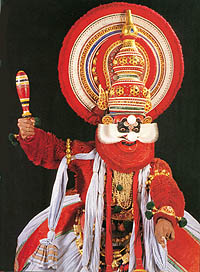 demonic roles are embodied by such
personages as Bakasura and Dushasana. They have a completely different make-up.
There is no white chutti across jaws and chin. The basic colour of make-up is
black and covers the eyes area and the most of forehead instead of usual red
signs outlined by a white line. These heroes are easy to recognize by huge
moustaches visible from under a complicated tracery made of paper and painted
red on which background black lips are sharply distinguished. An actor often
shows two white fangs in the corners of a mouth. White balls on nose and
forehead on the background of black and red face are the symbols of fierceness,
and they are much bigger than the heroes with the katthi have. Actors playing
thadi are usually tall and strong men with mighty figures capable of holding
extremely heavy and massive headdress. A red bearded (chavandu thadi) is a
strong earthly personality; he is uneducated and depresses everyone with his
presence. He walks arrogantly and constantly uses foul language. demonic roles are embodied by such
personages as Bakasura and Dushasana. They have a completely different make-up.
There is no white chutti across jaws and chin. The basic colour of make-up is
black and covers the eyes area and the most of forehead instead of usual red
signs outlined by a white line. These heroes are easy to recognize by huge
moustaches visible from under a complicated tracery made of paper and painted
red on which background black lips are sharply distinguished. An actor often
shows two white fangs in the corners of a mouth. White balls on nose and
forehead on the background of black and red face are the symbols of fierceness,
and they are much bigger than the heroes with the katthi have. Actors playing
thadi are usually tall and strong men with mighty figures capable of holding
extremely heavy and massive headdress. A red bearded (chavandu thadi) is a
strong earthly personality; he is uneducated and depresses everyone with his
presence. He walks arrogantly and constantly uses foul language.
Besides him the black bearded or karutta thadi take part in the performance.
These are primitive and ungovernable types embodying the lowest of the human
qualities. They are wild especially in comparison with the more refined heroes
of the drama. Their faces are totally painted black with a little of red and
white around eyes and with bright red lips. A chuttipo on nose is not a ball but
rather reminds an open flower. The headdress is not flat and round but long and
cylindrical, of black colour, opening or broadening on top. Karutta thadi is
represented by a katala or a hunter, and by a kirata or Shiva dressed as a
hunter. Another important representative of thadi is Kali, an evil personage who
also has black beard.
The monkey-kings of Bali and Sugriva possess certain animal qualities
characteristic of the monkey
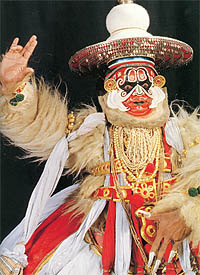 tribe, but it is Hanuman the divine monkey from
"Ramayana" who takes a special place in the hearts of people. His beard and a
fur jacket are white; his make-up is quite colourful especially on cheeks, on
the forehead and nose. The background of the make-up is red and black, but a
complex white tracery softens the strictness of these paints giving it in
general a rather calm and neutral character. Hanuman’s headdress consists of a
domelike crown; its flat basis rests on the head. Hanuman is one of the most
favourite heroes of the Kathakali drama, this role is usually given to a sincere
and experienced actor. tribe, but it is Hanuman the divine monkey from
"Ramayana" who takes a special place in the hearts of people. His beard and a
fur jacket are white; his make-up is quite colourful especially on cheeks, on
the forehead and nose. The background of the make-up is red and black, but a
complex white tracery softens the strictness of these paints giving it in
general a rather calm and neutral character. Hanuman’s headdress consists of a
domelike crown; its flat basis rests on the head. Hanuman is one of the most
favourite heroes of the Kathakali drama, this role is usually given to a sincere
and experienced actor.
Karis are the black personages, the background of their make-up is black and
they have black costumes on. This vesham (costume) is put on by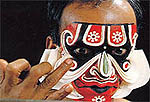 rakshasas or
demonesses like Purpanakha, Ravana’s evil sister. She also wears two false
breasts that emphasize her ugliness. rakshasas or
demonesses like Purpanakha, Ravana’s evil sister. She also wears two false
breasts that emphasize her ugliness.
Besides the heroes with the make-up background like pachkhi, katthi, thadi and
kari there are minor personages like minnaku that embody women and sages. The
colour of their faces is supposed to be natural but in fact the background of
their make-up is glittering and orange-yellow. Eyes and brows are penciled in a
natural way; their costumes are simple and realistic. These personages, be it a
woman or a sage, behave in a restrain and full of dignity manner. Sages are
obligatory to have a beard, hair is gathered in a knot and clothes are made of
fine material. Unlike major characters of the play, the minakku personages are
rather fragile people and this at times creates quite funny situations which
actors bring to their logical ends in order to slightly relieve the stress.
Female parts are traditionally played by men. That’s why their costumes are made
in such a way to hide their belonging to male sex. An actor exaggerates female
features in walking and behaving, special
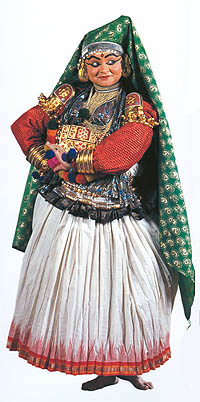 attention is paid to kalasamas be
performed lightly and elegantly. attention is paid to kalasamas be
performed lightly and elegantly.
Before the performance a Kathakali dancer puts a small seed in his eye. It
absorbs moisture and gives red hue to an eye. It balances the colour solution of
the rest of the make-up. Unlike the followers of other dance styles who are
identified with the style they belong to, Kathakali actors achieve individual
popularity as actors playing certain roles. It often happens that an actor
specializes in playing a role of one personage which he is eventually identified
with.
There are two singers and two drummers in the Kathakali Theater. Besides,
singers play instruments that keep up the rhythm and manage the musical
accompaniment in a certain way. Each drum has its definitely expressed sound.
Maddalam is a two-piece drum lake a mridangam, though larger. A performer wears
it on a belt and while playing he holds it low on hips. The fingertips on the
drummer’s right hand are covered with rice paste which hardens like plaster and
allows not only strike membrane without hurting fingers but also touch it
lightly when the development of the plot demands it. The other drum is of a
cylinder shape and is called chenda and is played in a standing position. It
hangs on a drummer’s shoulder and is played on with a palm of one hand and a
thin stick in the other hand or with two sticks one in each hand. In most cases
a drummer beats on chenda from one side.
This instrument accompanies only to male heroes. Aedakka is a drum of a smaller
size in the shape of a sand glass and is played when a female personage appears
on stage. It has a softer tone than a male chenda that sounds loud and sonorous
during the performance. The main singer keeps up the rhythm by striking a heavy
metal gong chengala with a thick and short stick. The second singer beats the
rhythm with a pair of heavy cymbals ilattalam. The singing style of Kathak is
close to that of Karnatak classic music but is called sopanam, the style of
performance that corresponds to expressive dance.
Kathakali is an absolute theatre. Singers sing text; actors render it with
gestures, pantomime, motions and dramatic playing. An actor’s mind, body and
heart simultaneously take part in the disclosing of a theme. He cooperates with
other personages and goes beyond the limits of a formal theatre, with the help
of gestures and pantomime creating an atmosphere in which he wishes to stand in
front of the audience. He "plays" the properties necessary for the role. He
creates a forest and goes through it. He portrays his beloved and then comes
close to her. He discloses his secret plan and then fulfills it. A spectator is
influenced on two levels: the belief in the world created by an actor fights
with the worship to the great mastery of actor playing.
A performance starts after the dark; drums beat fanciful rhythmic patterns
calling spectators to the performance. Evening turns into night gradually; the
characters appear on stage in the same gradual way. Time does not fetter them.
Wonderful actors play and demonstrate the unique virtuosity. At one moment of
this magic night the audience is immersed into sleepiness, at another moment it
is held in a restraint suspense. The climax of the night performance is the
fight. The noise becomes almost deafening. The audience waits for the dénouement
anxiously. Onstage a wild activity is going; a vortex of costumes and swords
raised high.
This is the great world of theatre. The reality comes with the dawn.
Based on the book "Rhythm In Joy" by Leela Samson
| 